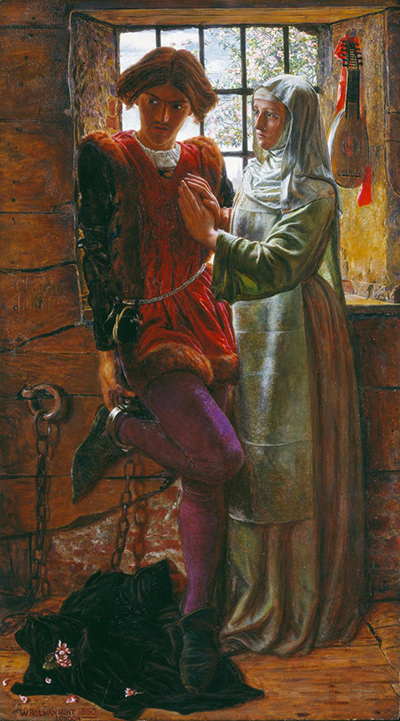William Holman Hunt's Claudio and Isabella is signed and dated 1850.
He painted it in oils on mahogany and inscribed the frame with words from "Measure for Measure" by William Shakespeare. The words are: "Claudio. Death is a fearful thing. Isabella. And shamed life a hateful".
The painting depicts a moment in "Measure for Measure" and presents a moral dilemma - subject matter which Holman Hunt loved. In the play, the character of Claudio was arrested when his mistress became pregnant outside of marriage.
The Duke's deputy, Angelo, sentences Claudio to death but is willing to spare his life if he can take Claudio's sister's virginity. Claudio's sister, Isabella, is chaste, pure and intends to enter the order of St. Clare and cannot contemplate such an idea.
Holman Hunt visited Lollard Prison at Lambeth Palace in order to paint his cell scene. His attention to detail is clearly visible in the way he has depicted the moss covered stone walls of the cell which suggest harsh conditions inside. If the viewer looks closely at the view through the cell window they can see a church spire beyond the blossoming fruit trees.
Claudio is portrayed with his face in shadows and looking away. He is shackled to the cell wall in an awkward pose. His sister, Isabella, stands upright and gazes earnestly into his eyes.
Her hands are placed upon his heart for she cannot agree to such a thing. The contrast in their clothing and postures helps to emphasise the passionate nature of Claudio and the virtuous nature of his sister.
On the wall is Claudio's lute which is adorned with a red ribbon further enhancing Claudio's personality. On the floor by his feet is a cloak. The petals were added later but add dramatic emphasis to the situation and suggest that Claudio was willing to let his sister sacrifice her virginity for his own life.
The painting was first exhibited in 1853 and was accompanied by a quote from Act 3 Scene 1 of "Measure to Measure". In 1864, Holman Hunt produced a pamphlet to advertise an engraving of the image in which he revealed the important moral of the picture: "Thou shall not do evil that good may come."
Claudio and Isabella now hangs in Tate Britain, their terrible dilemma for all to see and judge.




